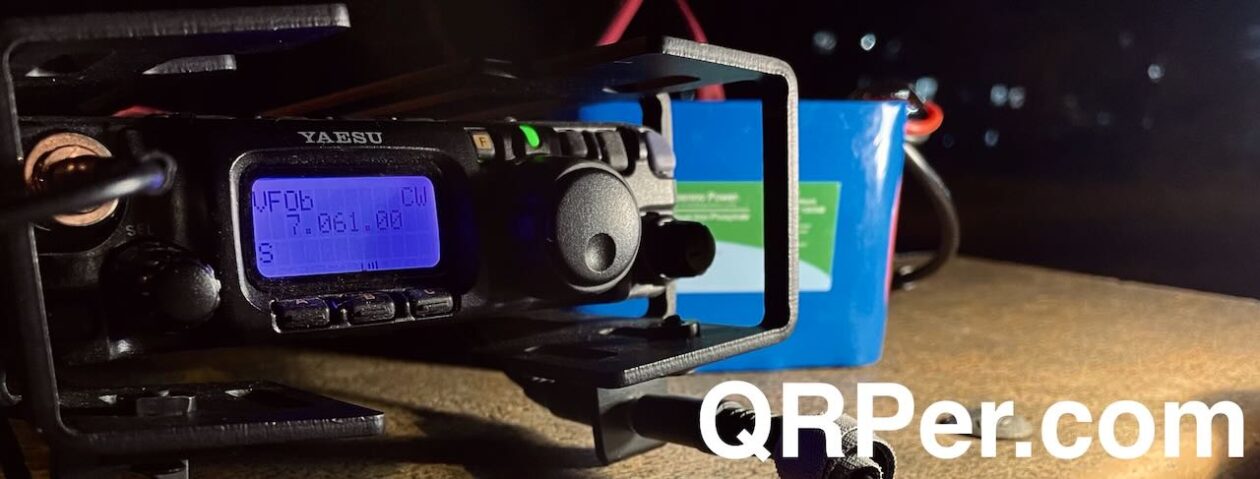As part of my amateur radio operations, I’ve quickly seen the advantage of having a small, portable radio I can operate anywhere and deploy quickly. Especially as I don’t have a permanent HF antenna installation at home, being able to set up in the yard (or even indoors) in a pinch is pretty high on the list of requirements for me.
I started reading online and watching videos about this topic, and found an excellent video from KT7RUN “The Tech Prepper” (and an earlier one) which showed a super-slick portable radio setup featuring the Yaesu FT-857D. Prior to finding those videos, I had already acquired an FT-857D due to its all-band, all-mode operation and compact size, and Gaston KT7RUN’s kit seemed like a very compelling setup for this radio.
Here’s what I’ve ended up with for my off-grid-capable “grab’n’go” radio station:

Inventory
Currently this is the inventory for this kit:
Antenna options:
and for charging this station in the field…
Details
Of course, the core of this kit is the radio. It’s popular for a reason. All-band, all-mode “shack in a box” in a truly portable form factor. Capable of 100w operation, it’s more than enough to make whatever contacts you need. In my case, because the battery has a max 20A continuous-discharge specification, I wouldn’t actually transmit at a full 100w with this exact configuration. Not a problem – I’m not expecting to transmit at those levels with a pack of this size.
The pack frame is truly solid, though it adds a good amount of weight (1.364lbs with all options). It’s absolutely worth it though. Not only does it provide rigidity and protection, it also provides convenient mount points for attachments, like the relocated antenna connections and Digirig holster. I could securely attach additional items if needed.
The battery just fits into the MOLLE pouch which is pretty lucky. I got a small PowerPole distribution block so I can not only connect the radio to the battery, but also the Genasun solar charge controller and whatever other power-related accessories I might use (e.g. Dakota Lithium’s 5v USB charger which I’ve adapted to PowerPole). Solar-wise, the charge controller I went with has a little more capacity than what I’m using currently with the 75w panel. I figured I should bump up to the 10amp charge controller to allow for a larger solar panel later on.

For CW operation I’ve relocated the jack with a basic 3.5mm audio extension cable going up through the bag and looped through the PALS webbing on the High Ground Gear PRC-117G bag. For a key I’m usually packing a basic 3d-printed iambic paddle I got at a swap meet for $20. I’d love a N0SA SP4 paddle but… $$$ :‘D
In the following photos you can see how I’ve laid out the relocation cables. I specifically took photos of these to show people who want to re-create this kit, because it was pretty tedious to get it all in there. Hopefully these will save someone a bit of time. 


All in all, this kit weighs in at 11 pounds. It’s a bit heavy to carry for a SOTA activation, but for POTA it’s no problem at all. I have indeed carried it up to a SOTA summit, but HF propagation conditions were poor and I was really struggling to make any contacts. Ended up resorting to activating on 2m with a tape measure Yagi. 
Because of the PALS webbing on the PRC-117G bag, this portable kit could be strapped to a larger backpack as needed, though typically I have just carried the kit inside my backpack, to keep the weight closer to my body. Perhaps more notably, additional accessory pouches could be attached, like a pouch for logbook/pencil/antennas/CW key etc.
Conclusion
So how is this kit to actually use? In a word, awesome. Drop it on the ground or on a table, deploy and attach an antenna, turn on the power. If I’m expecting to be on air for a long time, I can attach the solar charge controller and solar panel to keep the station running (though I have yet to do this while operating, since I completed this kit very recently). I can go out into the field and use this setup indefinitely, regardless of available electrical infrastructure.
For digital operations, I have a ToughBook CF-31 which is fully configured with all relevant software I’d typically use. This is great for tossing in the vehicle for a POTA activation, and even feasible for SOTA if you’re in great shape or willing to carry the extra weight. An alternative for digital ops could be a lightweight single-board-computer, tablet, or netbook, of course.
Just for fun, here’s a map of most of the QSOs I’ve made with this rig since putting it together. It’s not exhaustive, but what I could quickly gather up for this post. 133 contacts across 11 countries. The furthest contact thus far is with VK2WN on 30m FT8, at a nice 11965km (7435mi) distance, with just 5watts of output power on my side. Nice!

If you have any questions about this kit or would like additional details, please feel free to reach out. I’d also be curious to hear from anyone who follows this build and creates their own variation!
73 de VA7EKA
















































